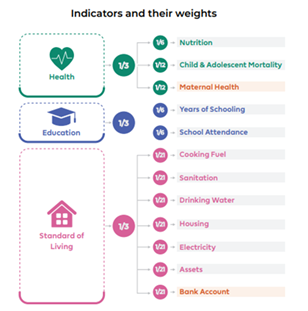-
- The National Multidimensional Poverty Index (MPI) is brought out by the NITI Aayog.
- It is a measure used to assess poverty that goes beyond traditional income-based indicators.
- It takes into account multiple dimensions of well-being, such as health, education, and living standards.
- Unlike income-based measures, which focus solely on financial resources, the MPI provides a more comprehensive understanding of poverty by considering various aspects of people’s lives.
- It is modeled on the Global MPI which is jointly published by the Oxford Poverty and Human Development Initiative (OPHI) and the United Nations Development Programme (UNDP).

The MPI includes 3 equal-weighted dimensions and within each dimension, there are various indicators having equal weights in the respective dimensions.
1. Health Dimension: Includes indicators related to nutrition, child mortality, and other health-related factors. For example, access to clean water, sanitation facilities, and basic health services may be considered.
2. Education Dimension: Encompasses indicators related to education, such as school attendance, completion rates, and literacy levels. Access to quality education and educational infrastructure is crucial in this dimension.
3. Living Standards Dimension: Focuses on living conditions and standards, considering factors such as housing quality, access to electricity, and assets owned by households.
Poverty Headcount Ratio: The Poverty Headcount Ratio is the proportion of multidimensionally poor in the population, which is arrived at by dividing the number of multidimensionally poor persons by total population. Latest Data: Steep decline in poverty Headcount Ratio from 24.85% in 2015-16 to 14.96% in 2019-21.
Intensity of Poverty: The Intensity of Poverty measures the average deprivation among the people living in multidimensional poverty. Latest data: The Intensity of poverty has reduced from 47.14% in 2015-16 to 44.39% in 2019-21.
Spread the Word
